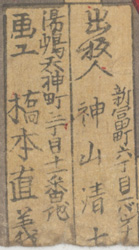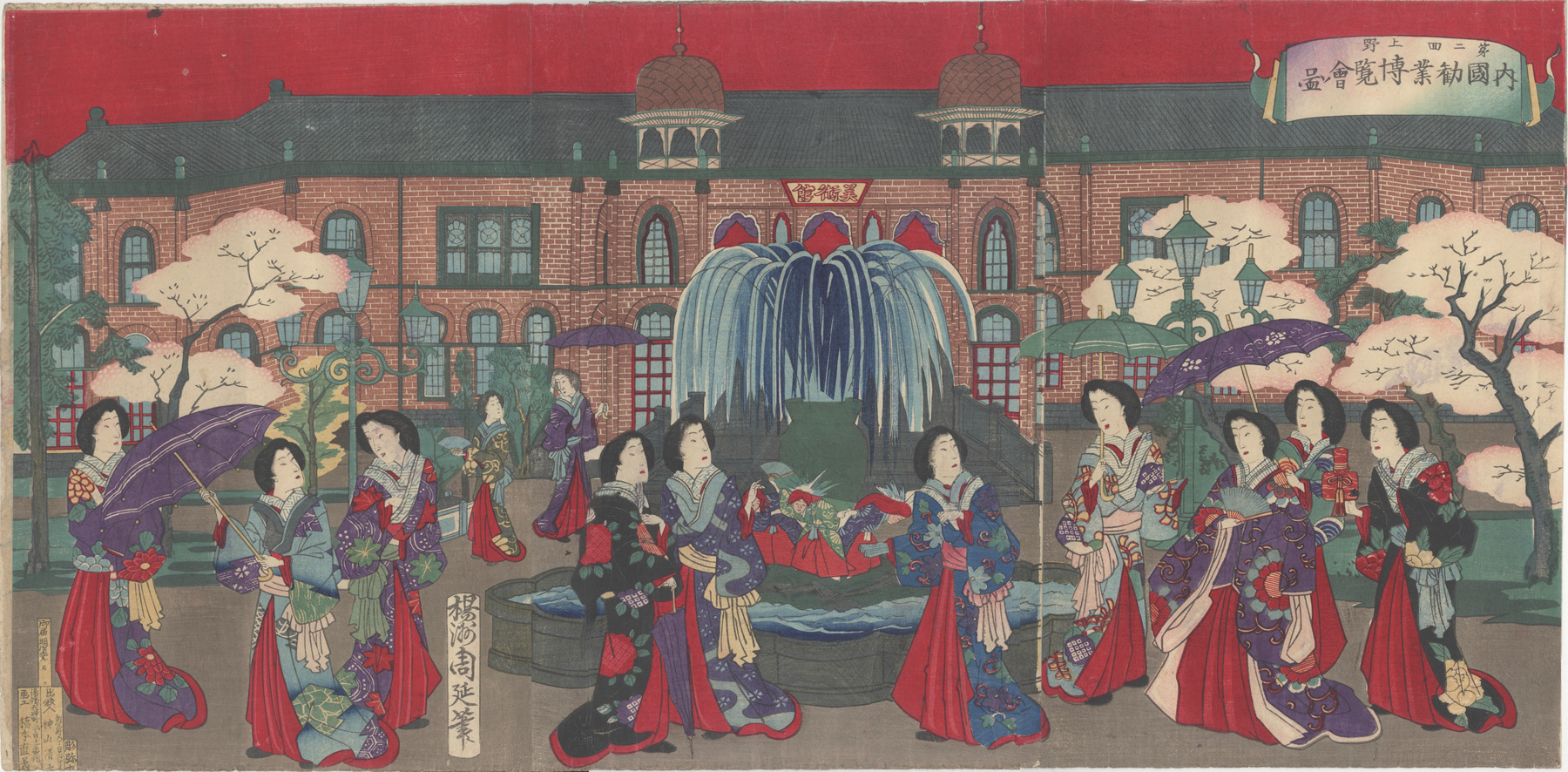About This Print
Another triptych by Chikanobu (also see IHL Cat. #105) picturing the courtyard, the Shōjō Fountain1 designed by the Yokohama potter Makuzu Kōzan [Miyagawa Kōzan] (1842- 1916) and the new art museum designed by Josian Conder in Tokyo's Ueno Park, scene of the Second National Industrial Exhibition. In this scene traditionally attired court ladies mingle in the courtyard. I do not now whether this was an imagined scene or if these ladies were part of the retinue of the Empress during her and the Emperor's special visit to the exhibition.The Second National Industrial Exhibtion
Source: National Diet Library http://www.ndl.go.jp/exposition/e/s1/naikoku2.html
Period: March 1, 1881 - June 30, 1881
Venue: Tokyo Ueno Park
No. of visitors: 823,094
The second National Industrial Exhibition was held at a time when Japan was experiencing inflation triggered by the efforts to raise funds to fight the Seinan Civil War (Satsuma Rebellion), as well as a recession caused by an outflow of specie due to trade imbalances after the opening of Japanese ports to the world at the end of the Edo period. Nevertheless, the number of exhibits displayed at the second exposition increased four-fold from that of the first event. In almost all aspects, such as the number of visitors, the second exposition surpassed the first. While the first was held under the jurisdiction of the Naimu-sho (Ministry of Home Affairs), the second was held under the Okura-sho (Ministry of Finance), in addition to the Naimu-sho, indicating that the entire government was focusing further efforts on this event.
In the approximately 143,000 m2 venue, the main building and six other exhibition structures were constructed. The second National Industrial Exhibition successfully attracted many visitors, partly because it was opened in March in anticipation for drawing many of the cherry-blossom viewers in Ueno. The total number of visitors during the event period was about 820,000, with a daily average of 6,740 visitors, almost double of that of the first exposition. The second exposition was visited by the Meiji Emperor and the Empress, who observed the event attentively.
As he had done at the first National Industrial Exhibition, G. Wagener, a foreigner employed by the Japanese government at that time, played a guidance role at the second National Industrial Exhibition. In his report to the Japanese government, he analyzed the situation of Japanese industries in those days and presented his recommendations for the future. One of his recommendations was that the Japanese agricultural industry should be developed with the introduction of overseas funds and technologies. Such recommendations were made as a form of resistance against the Japanese government, which had abolished the employment of foreigners at the Noshomu-sho (Ministry of Agriculture and Commerce). Thus, a contrast became clear between Wagener's beliefs and the Japanese government's policies of seeking independence from overseas technical experts.
At the first National Industrial Exhibition, items were exhibited according to the exhibitors' prefectures. At the second National Industrial Exhibition, exhibits were displayed in categories, in order to stir a sense of rivalry between the exhibitors. In anticipation of further improvement and development of the exhibits displayed at the first event, the second exposition prohibited the display of items similar to those exhibited at the first event.
Print Details
| IHL Catalog | #1222 |
| Title or Description | Illustration of the Second National Industrial Exposition at Ueno Park (第二回上野内国勧業博覧会ノ図 Daini uni Ueno naikoku kangyō hakurankai no zu) |
| Series | |
| Artist | Yōshū Chikanobu (1838-1912) |
| Signature |  |
| Seal | |
| Publication Date |  御届 明治十四年 |
| Publisher |  right side: publisher's address [Kyōbashi Shintomichō Rokuchōme 2-banchi] followed by publisher's name [Kamiyama Seishich]: 出版人 神山清七 left side: artist's address followed by artist's birth name [Hashimoto Naoyoshi]: 画工 橋本直義 |
| Carver | 彫弥太 Hori Yata  |
| Impression | excellent |
| Colors | excellent |
| Condition | fair – panels pasted together, album backing, multiple vertical folds; several worm holes |
| Genre | ukiyo-e; kaika-e |
| Miscellaneous | |
| Format | vertical oban triptych |
| H x W Paper | 13 7/8 x 28 1/8 in. (35.2 x 71.4 cm) |
| Literature | |
| Collections This Print | Cultural Heritage Online http://bunka.nii.ac.jp/heritages/detail/204226; National Diet Library http://dl.ndl.go.jp/info:ndljp/pid/1307421/1 |


